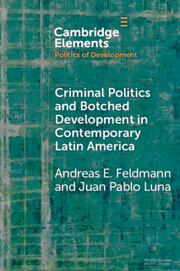Element contents
Criminal Politics and Botched Development in Contemporary Latin America
Published online by Cambridge University Press: 14 July 2023
Summary
- Type
- Element
- Information
- Online ISBN: 9781108955461Publisher: Cambridge University PressPrint publication: 10 August 2023
References
- 6
- Cited by

